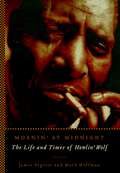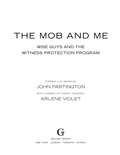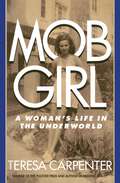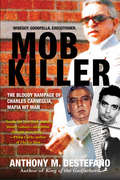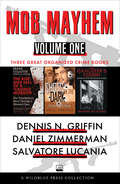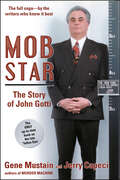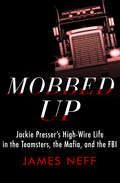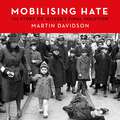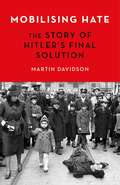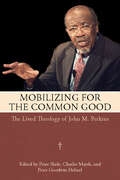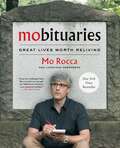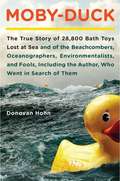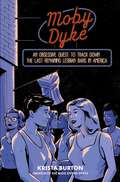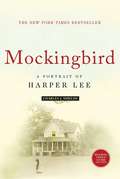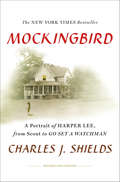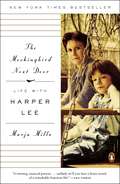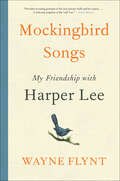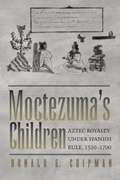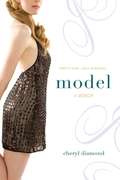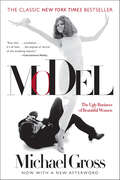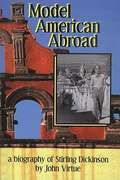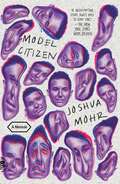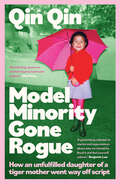- Table View
- List View
Moanin' at Midnight: The Life and Times of Howlin' Wolf
by James Segrest Mark Hoffman<P>Howlin' Wolf was a musical giant in every way. <P>He stood six foot three, weighed almost three hundred pounds, wore size sixteen shoes, and poured out his darkest sorrows onstage in a voice like a raging chainsaw. Half a century after his first hits, his sound still terrifies and inspires. <P>Born Chester Burnett in 1910, the Wolf survived a grim childhood and hardscrabble youth as a sharecropper in Mississippi. <P>He began his career playing and singing with the first Delta blues stars for two decades in perilous juke joints. <P>He was present at the birth of rock 'n' roll in Memphis, where Sam Phillips-who also discovered Elvis Presley, Johnny Cash, and Jerry Lee Lewis-called Wolf his "greatest discovery." <P>He helped develop the sound of electric blues and vied with rival Muddy Waters for the title of king of Chicago blues. He ended his career performing and recording with the world's most famous rock stars. <P>His passion for music kept him performing-despite devastating physical problems-right up to his death in 1976. <P>There's never been a comprehensive biography of the Wolf until now. Moanin' at Midnight is full of startling information about his mysterious early years, surprising and entertaining stories about his decades at the top, and never-before-seen photographs. It strips away all the myths to reveal-at long last-the real-life triumphs and tragedies of this blues titan.
The Mob and Me
by Violet PartingtonThis revealing first-person narrative, by one of the founders of the Witness Protection Program and a personal protector to more than five hundred informants, offers an eye-opening, dead-on authentic perspective on the safeguard institution. How did law enforcement's frustration with the criminal underworld and a serpentine series of hit-or-miss rules and mistakes give rise to one of the most significant and endlessly fascinating government-run programs of the 20th century? In 1967, U.S. Marshal John Partington was given the task of overseeing the protection of the wife and young daughter of renowned mobster Joe "The Animal" Barboza, now an informant with a bounty on his head. It wasn't Partington's first time guarding underworld witnesses. But this time was different. It was at the behest of Senator Bobby Kennedy that Partington became the architect of a new high- threat program to get the bad guys to testify against the worse guys. Lifelong protection in exchange for the conviction of the upper echelon of organized crime would require a permanent identity change for every member of the witness's family, a battery of psychological tests for re-assimilation, and a total, devastating obliteration of all ties with the past. With no blueprint for success, it created a logistical nightmare for Partington. He would have to make up the rules as he went along, and he did so without the luxury of knowing whom he could really trust at any given time. And so, the Witness Protection Program was born. The account John Partington tells of the next thirty years of his life is a never-before-seen portrait of members of the underworld and law enforcement--from Joe Valachi, the first mobster to violate the "omerta," the sacrosanct code of silence, to high-profile informant and NYPD narcotics detective Bob Leuci, immortalized in Prince of the City. He reveals the details of the protection provided such significant figures as Watergate players to Howard Hunt and John and Maureen Dean. Ultimately, Partington delivers the unvarnished truth of the Program, from the heavily-shielded delivery of witnesses to trial, to countless death threats, to managing an ever- rotating crew of U.S. Marshals, to the step-by-step procedure of reinventing his sometimes dangerous, sometimes terrified charges and their families as uncomplicated suburbanites. These would be the guarded new neighbors just across the street bearing secret histories--uncomfortable actors in a play that would run for the rest of their lives. Lifting a cloak of confidentiality and controversy, The Mob and Me immerses readers in the rarified, misunderstood world of Witness Protection--at once human, dangerous, intimate, surprising, and stone-cold violent.
Mob Girl: A Woman's Life In the Underworld
by Teresa CarpenterA Simon & Schuster eBook. Simon & Schuster has a great book for every reader.
Mob Killer: The Bloody Rampage of Charles Carneglia, Mafia Hit Man
by Anthony M. DestefanoA CRAZED KILLERHe dissolved the bodies of some of his victims in acid and poured them down the sewer. He hung grisly souvenirs on nails in his junkyard.LA COSA NOSTRACharles Carneglia was a stone-cold killer who fell in with the bloodthirsty John Gotti crew. As the infamous crime family rose to power with their murderous trail of sex, jealousy, greed, and revenge, Carneglia rose with them.MAFIA, MADNESS AND MURDERThis is the horrifying story of a misfit who fit perfectly into the New York mafia. In a harrowing journey inside a ruthless criminal underworld, Pulitzer Prize-winning reporter Anthony M. DeStefano chronicles one man’s life in a world of depraved acts of violence and the horrors that went with being a member of the Gambino family.“Thrilling American crime writing.” —Jimmy Breslin on King of the GodfathersIncludes 16 Pages of Shocking Photos
Mob Mayhem: Volume One (Mob Mayhem #1)
by Daniel ZimmermanIf you liked The Godfather and Goodfellas, you&’ll love these three up-close-and-personal true accounts of gangsters and organized crime.THE RISE AND FALL OF A &“CASINO&” MOBSTER: The Tony Spilotro Story Through a Hitman&’s Eyes by Frank Cullota and Dennis Griffin Bestselling &“mob expert&” Dennis Griffin and former mob enforcer and Spilotro confidant, Frank Cullota, tell the story of the Las Vegas gangster whose quest for power and lack of self-control with women cost the Mob its control of Vegas—and lost Tony his life. &“Sets the record straight about Tony the man and Tony the mobster. It&’s an eye-opener.&”—Frank Calabrese, Junior, author of Operation Family Secrets SHOTS IN THE DARK: The Saga of Rocco Balliro by Daniel Zimmerman In 1963, Rocco Balliro and a pair of associates stormed an apartment in Boston and were immediately caught in a shootout with Boston police officers, waiting in ambush for him. It was a rescue mission that went downhill in a hurry, leaving his beloved girlfriend and her toddler son dead. &“Fascinating . . . a real page-turner for Mob enthusiasts and organized crime history buffs.&”—Dennis N. Griffin, bestselling author of The Rise and Fall Of A &“Casino&” Mobster THE GANGSTER&’S COUSIN: Growing up in the Luciano Family by Salvatore Lucania Young Sal navigates the streets of Harlem, experiencing the inherent corruption of the US justice system and discovering the truth about the secret world of outlaw figures—like his cousin and namesake, Charles &“Lucky&” Luciano. &“A wonderfully different take on the usual Mafia story . . . a sometimes exciting, sometimes poignant, and often humorous adventure.&”—Thrive Global
Mob Star: The Story of John Gotti
by Gene Mustain Jerry CapeciHe was a little-known wiseguy out of Howard Beach, Queens, who blasted his way into the public eye with the assassination of Gambino Family boss Paul Castellano in December 1985, a rubout that&’s the stuff of Mafia legend. Ruthless, cunning, and tougher than the streets that produced him, John Gotti seized control of the nation&’s most powerful crime family, beat the law on rap after rap, and became an American legend. First published in 1988 and fully revised and updated for this edition, Mob Star traced John Gotti&’s spectacular rise and eventual downfall after the betrayal of his closest ally, Salvatore &“Sammy Bull&” Gravano. At his death, ten years after he was jailed for life and four years after he began battling cancer, John Gotti was still the biggest name in today&’s Mafia.
Mobbed Up: Jackie Presser's High-Wire Life in the Teamsters, the Mafia, and the FBI
by James NeffThe spellbinding saga of Teamster boss Jackie Presser's rise and fall In his rise from car thief to president of America's largest labor union, Jackie Presser used every ounce of his street smarts and rough-edged charisma to get ahead. He also had a lot of help along the way--not just from his father, Bill Presser, a Teamster power broker and thrice-convicted labor racketeer, but also from the Mob and the FBI. At the same time that he was taking orders from the Cleveland Mafia and New York crime boss Fat Tony Salerno, Presser was serving as the FBI's top informant on organized crime. Meticulously researched and dramatically told, Mobbed Up is the story of Presser's precarious balancing act with the Teamsters, the Mafia, and the Justice Department. Drawing on thousands of pages of classified files, James Neff follows the trail of greed, corruption, and hubris all the way to the Nixon and Reagan White Houses, where Bill and Jackie Presser were treated as valued friends. Winner of an Investigative Reporters & Editors Award for best reporting on organized crime, it is a tale too astonishing to be made up--and too troubling to be ignored.
Mobile Home: A Memoir in Essays (Association of Writers and Writing Programs Award For Creative Nonfiction Ser.)
by Megan HarlanUprooting ourselves and putting down roots elsewhere has become second nature. Americans are among the most mobile people on the planet, moving house an average of nine times in adulthood. This book explores one family's extreme and often international version of this common experience. Inspired by the author's globe-wandering childhood-during which she lived in seventeen homes across four continents, ranging in location from the Alaskan tundra to a Colombian jungle, a posh flat in London to a doublewide trailer near the Arabian Gulf-the book maps the emotional structures and metaphysical geographies of home. In ten interconnected essays, the author examines cultural histories that include Bedouin nomadic traditions and modern life in wheeled mobile homes, the psychology of motels and suburban tract housing, and the lived meanings within the built landscapes of Manhattan, Stonehenge, and the Winchester Mystery House. More personally, she traces the family histories that drove her parents to seek so many new horizons-and how those places shaped her upbringing. Her mother viewed houses as a kind of large-scale plastic art ever in need of renovating, while her father was a natural adventurer and loved nothing more than to travel, choosing a life of flight that also helped to mask his addiction to alcohol. These familial experiences color the author's current journey as a mother attempting to shape a flourishing, rooted world for her son. Her memoir in essays skillfully explores the flexible, continually inventive natures of place, family, and home.
Mobilising Hate: The Story of Hitler's Final Solution
by Martin Davidson'Finally, eight decades on, there comes a convincing reason as to how an entire nation was able to swallow and then endorse the warped ideology of Hitler and the Nazis. Not only a brilliantly argued book, Mobilising Hate is also a grimly compelling and utterly absorbing examination of one of the most terrible events in world history. Martin Davidson's meticulous and scholarly research and exquisite writing has provided us with one of the most important books ever written on the subject.' JAMES HOLLAND'A highly readable thesis of how ordinary people were turned into monsters by the malevolent propaganda of Hitler and his henchmen ... A very good book.' SAUL DAVID, TelegraphBy 1942, it was an article of faith that what the Nazis called 'The Jewish Question' had only one answer: the mass extermination of an entire people. Six million European Jews were savagely murdered as a result of this perverted but profoundly held conviction. In this radical new perspective on Hitler's so-called 'Final Solution', Martin Davidson shows that the terrible fate of Europe's Jews was not one Nazi policy amongst many, but the central preoccupation of the regime, one which they were determined to achieve and of which they were most chillingly proud. How were so many people convinced that the Jews deserved such treatment - or were at least persuaded to shrug their shoulders and turn a blind eye? Why did they think Germany could only be reborn with their eradication? That Jewish suffering was not only necessary, but deserved? How were the moral standards of an entire nation so warped and perverted, that the Final Solution came to be regarded as a rational, thrilling, even sacred, element of Nazi state policy? Mobilising Hate examines in detail how Nazi ideologues worked to frame and amplify anti-Jewish feeling in Germany. Davidson explores the origins of radical anti-Jewish polemic in the volcanic upheavals that swept over Germany in the months after the First World War. How it seeded a theory that claimed to explain the truth of the entirety of human history. How that theory would go on to pervert science; corrupt the law; rewrite history; taint art, music and literature; and turn the media into the servant of a brutal and pitiless regime with a single message to communicate: destroying Jews lives was the indispensable first step to making Germany - and indeed, Europe - great again. Davidson goes on to track the way in which Nazi leaders moved from theory to practice, by accident and by design, skilfully dramatising the many twists and turns that would lead to Auschwitz and beyond, many of which are not generally included in conventional accounts. Mobilising Hate is driven by the first-hand accounts of many of those defined by the Nazi genocide; both its architects and perpetrators, as well as its targeted victims. Poignantly too, the book turns the spotlight on the whistle-blowers who saw, recorded and shared accounts of the horrors unfolding across the continent - only to be greeted time and time again, with guarded and non-committal hedging from Allied governments. Many people inside Germany, and across the world, knew, but, it seemed, very few felt they needed to care. As our world once again grapples with the challenges of global mass resentment, economic insecurity and the growing desire to find people - entire populations - at whom to point the finger of blame, the issue of Hitler's Final Solution and the thinking that gave birth to it have worrying new resonance. Rarely has the 'warning from history' been so acute, nor the refrain 'never again', been so heartfelt. Above all, Mobilising Hate is the story of how the Nazis spawned a vision of 'us' and 'them', that taken to its logical conclusion, spelled a death sentence for millions. Hitler may have lacked an early masterplan for the mass extermination of Europe's Jews, but it would be his zealously constructed policies and unflinching determination to see them
Mobilising Hate: The Story of Hitler's Final Solution
by Martin DavidsonPraise for The Perfect Nazi:'Absorbing, highly readable and painstakingly researched' NIALL FERGUSON 'Unforgettable, haunting reading' SIMON SCHAMA'A fascinating and extraordinary journey into the banality of evil at the heart of Nazism' BEN MACINTYREBy 1942, it was an article of faith that what the Nazis called 'The Jewish Question' had only one answer: the mass extermination of an entire people. Six million European Jews were savagely murdered as a result of this perverted but profoundly held conviction. In this radical new perspective on Hitler's so-called 'Final Solution', Martin Davidson shows that the terrible fate of Europe's Jews was not one Nazi policy amongst many, but the central preoccupation of the regime, one which they were determined to achieve and of which they were most chillingly proud. How were so many people convinced that the Jews deserved such treatment - or were at least persuaded to shrug their shoulders and turn a blind eye? Why did they think Germany could only be reborn with their eradication? That Jewish suffering was not only necessary, but deserved? How were the moral standards of an entire nation so warped and perverted, that the Final Solution came to be regarded as a rational, thrilling, even sacred, element of Nazi state policy? Mobilising Hate examines in detail how Nazi ideologues worked to frame and amplify anti-Jewish feeling in Germany. Davidson explores the origins of radical anti-Jewish polemic in the volcanic upheavals that swept over Germany in the months after the First World War. How it seeded a theory that claimed to explain the truth of the entirety of human history. How that theory would go on to pervert science; corrupt the law; rewrite history; taint art, music and literature; and turn the media into the servant of a brutal and pitiless regime with a single message to communicate: destroying Jews lives was the indispensable first step to making Germany - and indeed, Europe - great again. Davidson goes on to track the way in which Nazi leaders moved from theory to practice, by accident and by design, skilfully dramatising the many twists and turns that would lead to Auschwitz and beyond, many of which are not generally included in conventional accounts. Mobilising Hate is driven by the first-hand accounts of many of those defined by the Nazi genocide; both its architects and perpetrators, as well as its targeted victims. Poignantly too, the book turns the spotlight on the whistle-blowers who saw, recorded and shared accounts of the horrors unfolding across the continent - only to be greeted time and time again, with guarded and non-committal hedging from Allied governments. Many people inside Germany, and across the world, knew, but, it seemed, very few felt they needed to care. As our world once again grapples with the challenges of global mass resentment, economic insecurity and the growing desire to find people - entire populations - at whom to point the finger of blame, the issue of Hitler's Final Solution and the thinking that gave birth to it have worrying new resonance. Rarely has the 'warning from history' been so acute, nor the refrain 'never again', been so heartfelt. Above all, Mobilising Hate is the story of how the Nazis spawned a vision of 'us' and 'them', that taken to its logical conclusion, spelled a death sentence for millions. Hitler may have lacked an early masterplan for the mass extermination of Europe's Jews, but it would be his zealously constructed policies and unflinching determination to see them through to the bitter end that would make it impossible for his Nazi Holocaust not to happen. That the Jews should face total extermination was Hitler's biggest, proudest prophecy, and the one he moved mountains to make come true, no matter the cost.
Mobilizing for the Common Good: The Lived Theology of John M. Perkins
by John M. PerkinsBorn into a sharecropping family in New Hebron, Mississippi, in 1930, and only receiving a third-grade education, John M. Perkins has been a pioneering prophetic African American voice for reconciliation and social justice to America's white evangelical churches. Often an unwelcome voice and always a passionate, provocative clarion, Perkins persisted for forty years in bringing about the formation of the Christian Community Development Association—a large network of evangelical churches and community organizations working in America's poorest communities—and inspired the emerging generation of young evangelicals concerned with releasing the Church from its cultural captivity and oppressive materialism. John M. Perkins has received surprisingly little attention from historians of modern American religious history and theologians. Mobilizing for the Common Good is an exploration of his theological significance. With contributions from theologians, historians, and activists, this book contends that Perkins ushered in a paradigm shift in twentieth-century evangelical theology that continues to influence Christian community development projects and social justice activists today.
Mobituaries: Great Lives Worth Reliving
by Mo RoccaFrom beloved CBS Sunday Morning correspondent and humorist Mo Rocca, an entertaining and rigorously researched book that celebrates the dead people who have long fascinated him. <P><P>Mo Rocca has always loved obituaries—reading about the remarkable lives of global leaders, Hollywood heavyweights, and innovators who changed the world. But not every notable life has gotten the send-off it deserves. His quest to right that wrong inspired Mobituaries, his #1 hit podcast. <P><P>Now with Mobituaries, the book, he has gone much further, with all new essays on artists, entertainers, sports stars, political pioneers, founding fathers, and more. Even if you know the names, you’ve never understood why they matter...until now. Take Herbert Hoover: before he was president, he was the “Great Humanitarian,” the man who saved tens of millions from starvation. But after less than a year in the White House, the stock market crashed, and all the good he had done seemed to be forgotten. <P><P>Then there’s Marlene Dietrich, well remembered as a screen goddess, less remembered as a great patriot. Alongside American servicemen on the front lines during World War II, she risked her life to help defeat the Nazis of her native Germany. And what about Billy Carter and history’s unruly presidential brothers? Were they ne’er-do-well liabilities…or secret weapons? <P><P>Plus, Mobits for dead sports teams, dead countries, the dearly departed station wagon, and dragons. Yes, dragons. Rocca is an expert researcher and storyteller. He draws on these skills here. With his dogged reporting and trademark wit, Rocca brings these men and women back to life like no one else can. Mobituaries is an insightful and unconventional account of the people who made life worth living for the rest of us, one that asks us to think about who gets remembered, and why. <P><P><b>A New York Times Bestseller</b>
Moby-Duck: The True Story of 28,800 Bath Toys Lost at Sea and of the Beachcombers, Oceanographers, Environmentalists, and Fools, Including the Author, Who Went in Search of Them
by Donovan HohnA revelatory tale of science, adventure, and modern myth, "Moby-Duck" is the true story of 28,800 bath toys lost at sea, and of the people who went after them.
Moby Dyke: An Obsessive Quest To Track Down The Last Remaining Lesbian Bars In America
by Krista BurtonA former Rookie contributor and creator of the popular blog Effing Dykes investigates the disappearance of America&’s lesbian bars by visiting the last few in existence.Lesbian bars have always been treasured safe spaces for their customers, providing not only a good time but a shelter from societal alienation and outright persecution. In 1987, there were 206 of them in America. Today, only a couple dozen remain. How and why did this happen? What has been lost—or possibly gained—by such a decline? What transpires when marginalized communities become more accepted and mainstream? In Moby Dyke, Krista Burton attempts to answer these questions firsthand, venturing on an epic cross-country pilgrimage to the last few remaining dyke bars. Her pilgrimage includes taking in her first drag show since the onset of the pandemic at The Back Door in Bloomington, Indiana; competing in dildo races at Houston&’s Pearl Bar; and, despite her deep-seated hatred of karaoke, joining a group serenade at Nashville&’s Lipstick Lounge and enjoying the dreaded pastime for the first time in her life. While Burton sets out on the excursion to assess the current state of lesbian bars, she also winds up examining her own personal journey, from coming out to her Mormon parents to recently marrying her husband, a trans man whose presence on the trip underscores the important conversation about who precisely is welcome in certain queer spaces—and how they and their occupants continue to evolve. Moby Dyke is an insightful and hilarious travelogue that celebrates the kind of community that can only be found in windowless rooms soundtracked by Britney Spears-heavy playlists and illuminated by overhead holiday lights no matter the time of year.
Mockingbird: A Portrait of Harper Lee
by Charles J. ShieldsTo Kill a Mockingbird--the twentieth century's most widely read American novel--has sold thirty million copies and still sells a million yearly. Yet despite her book's perennial popularity, its creator, Harper Lee, has become a somewhat mysterious figure. Now, after years of research, Charles J. Shields brings to life the warmhearted, high-spirited, and occasionally hardheaded woman who gave us two of American literature's most unforgettable characters--Atticus Finch and his daughter, Scout. At the center of Shields's evocative, lively book is the story of Lee's struggle to create her famous novel, but her colorful life contains many highlights--her girlhood as a tomboy in overalls in tiny Monroeville, Alabama; the murder trial that made her beloved father's reputation and inspired her great work; her journey to Kansas as Truman Capote's ally and research assistant to help report the story ofIn Cold Blood. Mockingbird--unique, highly entertaining, filled with humor and heart--is a wide-ranging, idiosyncratic portrait of a writer, her dream, and the place and people whom she made immortal.
Mockingbird: A Portrait of Harper Lee, from Scout to Go Set a Watchman
by Charles J. ShieldsAn extensively revised and updated edition of the bestselling biography of Harper Lee, reframed from the perspective of the recent publication of Lee's Go Set a WatchmanTo Kill a Mockingbird—the twentieth century's most widely read American novel—has sold thirty million copies and still sells a million yearly. In this in-depth biography, first published in 2006, Charles J. Shields brings to life the woman who gave us two of American literature's most unforgettable characters, Atticus Finch and his daughter, Scout.Years after its initial publication—with revisions throughout the book and a new epilogue—Shields finishes the story of Harper Lee's life, up to its end. There's her former agent getting her to transfer the copyright for To Kill a Mockingbird to him, the death of Lee's dear sister Alice, a fuller portrait of Lee’s editor, Tay Hohoff, and—most vitally—the release of Lee's long-buried first novel and the ensuing public devouring of what has truly become the book of the year, if not the decade: Lee's Go Set a Watchman.
The Mockingbird Next Door: Life with Harper Lee
by Marja MillsTo Kill a Mockingbird by Harper Lee is one of the best loved novels of the twentieth century. But for the last fifty years, the novel's celebrated author, Harper Lee, has said almost nothing on the record. Journalists have trekked to her hometown of Monroeville, Alabama, where Harper Lee, known to her friends as Nelle, has lived with her sister, Alice, for decades, trying and failing to get an interview with the author. But in 2001, the Lee sisters opened their door to Chicago Tribune journalist Marja Mills. It was the beginning of a long conversation--and a great friendship. In 2004, with the Lees' blessing, Mills moved into the house next door to the sisters. She spent the next eighteen months there, sharing coffee at McDonalds and trips to the Laundromat with Nelle, feeding the ducks and going out for catfish supper with the sisters, and exploring all over lower Alabama with the Lees' inner circle of friends. Nelle shared her love of history, literature, and the Southern way of life with Mills, as well as her keen sense of how journalism should be practiced. As the sisters decided to let Mills tell their story, Nelle helped make sure she was getting the story--and the South--right. Alice, the keeper of the Lee family history, shared the stories of their family. The Mockingbird Next Door is the story of Mills's friendship with the Lee sisters. It is a testament to the great intelligence, sharp wit, and tremendous storytelling power of these two women, especially that of Nelle. Mills was given a rare opportunity to know Nelle Harper Lee, to be part of the Lees' life in Alabama, and to hear them reflect on their upbringing, their corner of the Deep South, how To Kill a Mockingbird affected their lives, and why Nelle Harper Lee chose to never write another novel.
Mockingbird Songs: My Friendship with Harper Lee
by Wayne FlyntAn indelible portrait of one of the most famous and beloved authors in the canon of American literature—a collection of letters between Harper Lee and one of her closest friends that reveals the famously private writer as never before, in her own words.The violent racism of the American South drove Wayne Flynt away from his home state of Alabama, but the publication of To Kill a Mockingbird, Harper Lee’s classic novel about courage, community, and equality, inspired him to return in the early 1960s and craft a career documenting and teaching Alabama history. His writing resonated with many Alabamians, in particular three sisters: Louise, Alice, and Nelle Harper Lee. Beginning with their first meeting in 1983, a mutual respect and affection for the state’s history and literature matured into a deep friendship between two families who can trace their roots there back more than five generations. Flynt and Nelle Harper Lee began writing to one other while she was living in New York—heartfelt, insightful, and humorous letters in which they swapped stories, information, and opinions on topics both personal and professional: their families, books, Alabama history and social values, health concerns, and even their fears and accomplishments. Though their earliest missives began formally—"Dear Dr. Flynt"—as the years passed and their mutual admiration grew, their exchanges became more intimate and emotional, opening with "Dear Friend" and closing with "I love you, Nelle." Through their enduring correspondence, the Lees and the Flynts became completely immersed in each other’s lives.Beautifully written, intelligent, and telling, this remarkable compendium of their letters—a correspondence that lasted for a quarter century, from 1992 until Harper Lee’s death in February 2016—offers an incisive and compelling look into the mind, heart, and work of one of the most beloved authors in modern literary history.
Moctezuma's Children: Aztec Royalty under Spanish Rule, 1520-1700
by Donald E. ChipmanThough the Aztec Empire fell to Spain in 1521, three principal heirs of the last emperor, Moctezuma II, survived the conquest and were later acknowledged by the Spanish victors as reyes naturales (natural kings or monarchs) who possessed certain inalienable rights as Indian royalty. For their part, the descendants of Moctezuma II used Spanish law and customs to maintain and enhance their status throughout the colonial period, achieving titles of knighthood and nobility in Mexico and Spain. So respected were they that a Moctezuma descendant by marriage became Viceroy of New Spain (colonial Mexico's highest governmental office) in 1696.
Model
by Cheryl DiamondEvery year, hundreds of the most beautiful people in the world come to New York to become models. At age fourteen, Cheryl Diamond was one of them. Living on her own in a run-down apartment, Cheryl spent her days on go-sees, runways, and shoots, surviving hand-to-mouth, while taking in everything she could about the tough and sleazy modeling industry. She watched other girls make mistakes, and swore she wouldn't be a victim. . . until a career-altering event changed her life and nearly ruined her shot at her dream. This is the riveting, true account of Cheryl's triumphant rise, disastrous fall, and phoenix-like comeback in one of the hottest and most demanding industries in the world.
Model: The Ugly Business of Beautiful Women
by Michael GrossInvestigative journalist Michael Gross delves into the history of models and takes us into the private studios and hidden villas where models play and are preyed upon, going beyond modeling’s carefully constructed facade of glamour to expose the scandal and untold truths that permeate the seemingly glamorous business.Here for the first time is the complete story of the international model business—and its evil twin: legalized flesh peddling. It’s a tale of vast sums of money, rape both symbolic and of the flesh, sex and drugs, obsession and tragic death. At its heart is the most unholy combination in commerce: beautiful, young women and rich, lascivious men.Fashion insider Michael Gross has interviewed modeling’s pioneers, survivors, and hangers–on, and he tells the story of the greats: Lisa Fonssagrives; Anita Colby, Candy Jones; Dorian Leigh and her sister Suzy Parker; Jean Shrimpton and Twiggy; Veruschka and Lauren Hutton; and today’s supermodel trinity, Christy, Naomi and Linda.
The Model American Abroad
by John VirtueThe untold story of Stirling Dickinson, the shy Chicago millionaire who made San Miguel de Allende, Mexico, a famous art colony. The book describes Dickinson's philanthropy and his love for Mexico and its people.
Model Citizen: A Memoir
by Joshua MohrThe intimate, gorgeous, garish confessions of Joshua Mohr—writer, father, alcoholic, addictHer teeth marks in the wood are some of my favorite things. Every now and again she rips the pick out of my hand and tosses it inside the guitar . . . I hold it over my head, hole down, shaking it back and forth, the pick rattling around in there. And as it ricochets from side to side, I always think about pills. Maybe the pick has turned into oxy. Or Norco, codeine, Demerol. Maybe it’s a pill and when it falls out I can gobble it up.After years of hard-won sobriety, while rebuilding a life with his wife and young daughter, thirty-five-year-old Joshua Mohr suffers a stroke—his third, it turns out— which uncovers a heart condition requiring surgery. Which requires fentanyl, one of his myriad drugs of choice. This forced “freelapse” should fix his heart, but what will it do to his sobriety? And what if it doesn’t work?Told in stunning, surreal, time-hopping vignettes, Model Citizen is a raw, revealing portrait of an addict. Mohr shines a harsh spotlight into all corners of his life, throwing the wild joys, tragedies, embarrassments, and adventures of his past into bold relief.Pulsing with humanity and humor, revealing the immediacy of an addict climbing out of the murky pit of his past, Model Citizen is a darkly beautiful, incisive confession.
Model Minority Gone Rogue: How an unfulfilled daughter of a tiger mother went way off script
by Qin QinWe all grow up with rules. Do this, be this, don't be that. Qin Qin was all about the rules: do your homework, be good, don't rock the boat. She was the model daughter, model student and model minority.But doing everything right? It made her lost and miserable. So she decided to take a spectacular risk and change everything.At 23, Qin Qin was an unhappy overachiever working for a prestigious law firm. So she quit. She didn't know what else was out there, but she wanted to find out. She changed paths, changed countries, changed her entire view of what the world could be, and who she could be - with some primal screaming and tree-hugging along the way.In the process, she discovered the person she truly was, not who she thought she should be.Model Minority Gone Rogue is a funny, sad, exhilarating and thought-provoking true story about what happens when you want to live life on your own terms, even when those terms go against everything you've ever known. It's a story of what happens when you choose love over fear and honour your authentic self: life can be bigger and brighter than anything you had ever imagined.'Qin Qin is a living example of the adage: screw things up, thoughtfully. With every chapter of her story, she illuminates an alternative model to the corrosive stories we've taken on and been told about what we should be, rather than who we could be. Read this and feel yourself untangle and unknot.' BENJAMIN LAW, author, journalist and broadcaster'Model Minority Gone Rogue is about finding yourself against the expectations your parents, society and gender set out for you and courageously venturing into uncharted terrain ... It is illuminating, generous and full of gutsy hard-won wisdom.' ALICE PUNG, bestselling author of Unpolished Gem'I wish this book had existed when I was growing up. It will shock you, move you and educate you. It is essential reading for anyone who wants to know more about the experience of being an Australian of Chinese heritage.' SUE-LIN WONG, award-winning The Economist correspondent and The Prince podcast host'Bold and frequently surprising, Qin Qin brings the same challenge to her readers as she has for her hard-won identity: grow, love and question everything! Model Minority Gone Rogue is a book for anyone who has ever screamed on the inside, with powerful and unyielding observations on sex, race, the body and feminism.' CADANCE BELL, author and TV producer, writer and director'Sassy, sad, funny, unvarnished.' CANBERRA TIMES
